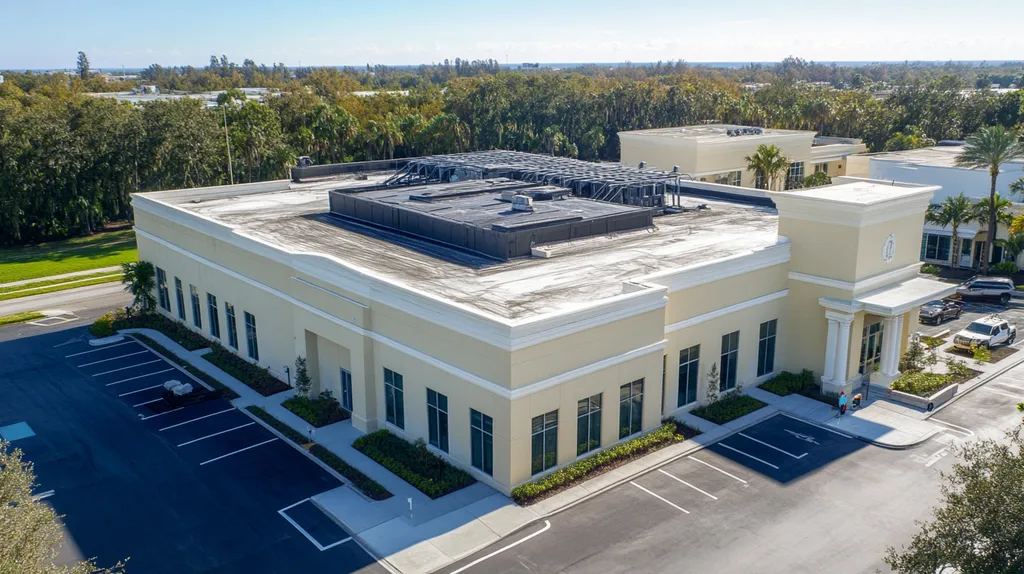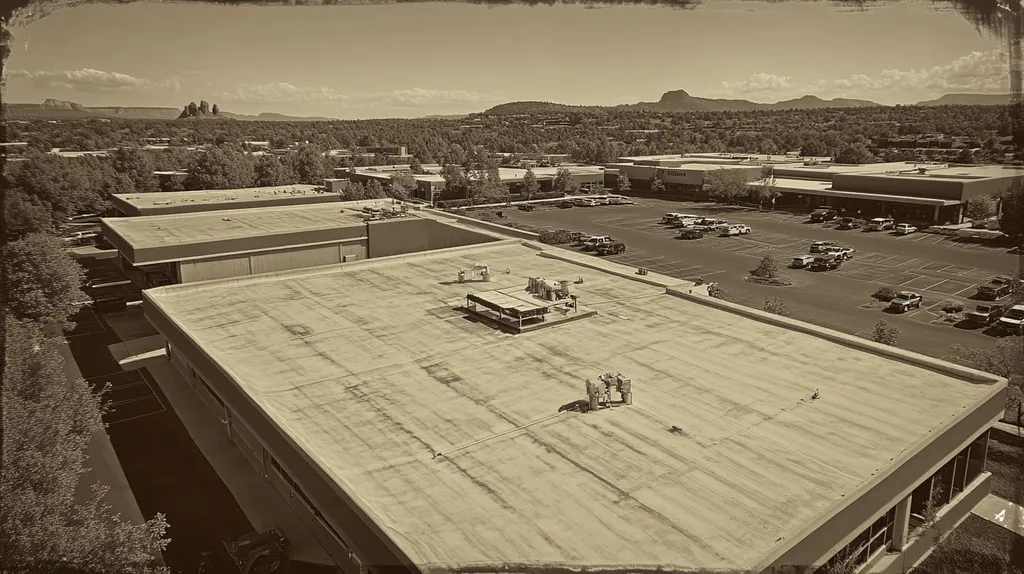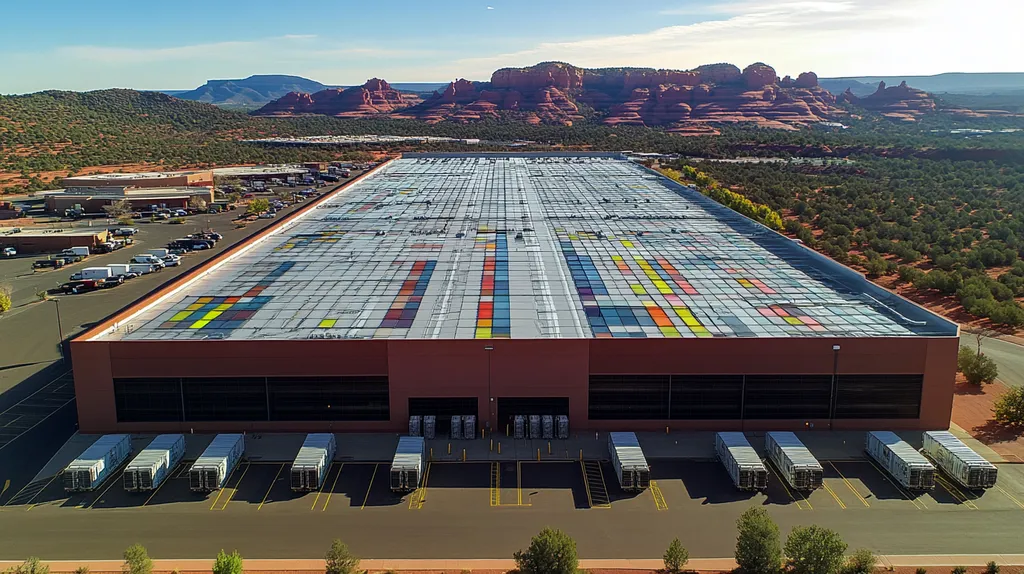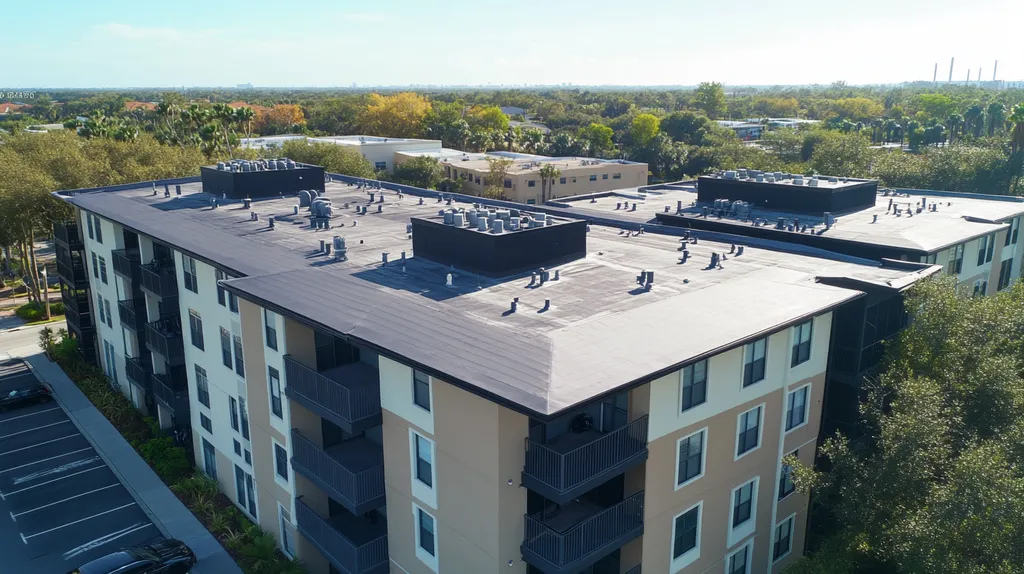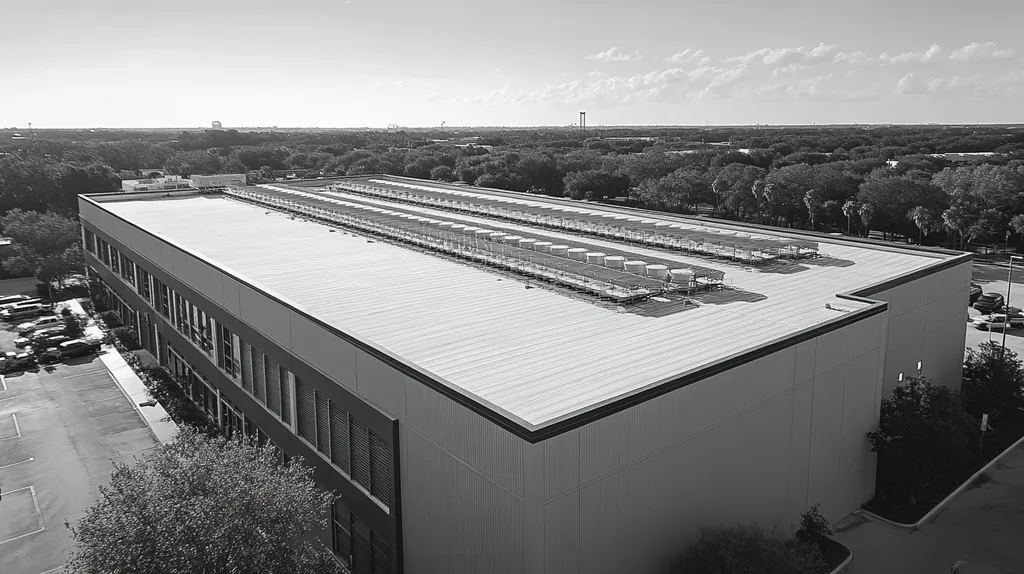Every year, industrial roof failures cost North American businesses over $2.5 billion in damages, with emergency response time directly impacting the severity of losses. Studies show that facilities without established emergency protocols face repair costs up to 400% higher than those with comprehensive response plans.
For facility managers and property owners, understanding and implementing proper emergency roof repair protocols isn’t just about protecting physical assets – it’s about ensuring business continuity and worker safety.
This manual provides a systematic approach to emergency roof repairs, from initial response through long-term maintenance, helping facilities minimize downtime and optimize repair outcomes.
SECTION 1: FUNDAMENTAL CONCEPTS
Industrial roof failures can trigger catastrophic consequences, from devastating equipment damage to complete operational shutdowns. Every hour of delay in emergency response can multiply repair costs exponentially while threatening worker safety and business continuity. Understanding and implementing proper emergency protocols isn’t just about protecting physical assets – it’s about safeguarding entire business operations and the livelihoods that depend on them.
Principles of Emergency Roof Repair Response
The cornerstone of effective emergency response lies in preparation and systematic execution. Facility managers must establish clear chains of command and decision-making protocols before emergencies occur, ensuring that response teams can mobilize within minutes of incident reports.
Documentation and assessment tools should be readily accessible, including detailed roof plans, maintenance histories, and emergency contact information. These resources enable rapid situation analysis and informed decision-making during critical moments.
Response teams need pre-designated staging areas and equipment caches strategically positioned throughout the facility. This preparation minimizes response time and ensures necessary tools are immediately available when needed.
Regular emergency response drills help identify potential bottlenecks and refine protocols before actual emergencies occur. These practice scenarios build team confidence and reveal gaps in preparation that could prove costly during real incidents.
Common Causes of Industrial Roof Failures
Weather events remain the primary trigger for emergency roof situations, with wind damage and water infiltration leading the list. Understanding these patterns helps facilities teams anticipate and prepare for seasonal vulnerabilities.
Structural stress points develop around HVAC units, skylights, and other roof penetrations. These areas require particular attention during inspections as they often serve as early warning indicators of developing problems.
Material fatigue accelerates when minor damage goes unaddressed, creating compound effects that can suddenly manifest as major failures. Regular monitoring of known stress points can prevent such cascading failures.
Chemical exposure from industrial processes or environmental factors can deteriorate roofing materials faster than expected. This often-overlooked factor requires specialized inspection protocols and potentially modified maintenance schedules.
Safety Protocols During Roof Emergencies
Safety measures must be systematically implemented before any emergency repair work begins. Warning lines must be erected at least 6 feet from roof edges, with high-visibility flags placed every 6 feet to clearly mark work zones.
All skylights and roof openings require proper covers capable of supporting substantial weight loads. These protective measures prevent fall-through accidents during emergency repairs when visibility may be compromised.
Emergency response teams must utilize proper fall protection equipment, including harnesses rated for industrial use. This equipment requires regular inspection and certification to ensure reliability during critical situations. (source: OSHA)
Communication protocols between ground teams and roof workers need clear establishment, with redundant systems in place. These protocols ensure coordinated responses and immediate notification if conditions deteriorate.
SECTION 2: SYSTEM COMPONENTS
Industrial roof emergencies can rapidly escalate from minor issues to major catastrophes. Studies indicate that up to 85% of premature roof failures stem from poor understanding of system components and their interactions. A comprehensive grasp of roofing materials, structural elements, and repair options enables facility managers to make swift, informed decisions during emergencies while minimizing costly operational disruptions.
Critical Roofing Materials and Their Vulnerabilities
Modern industrial roofing systems utilize diverse materials, each with specific vulnerabilities. Single-ply membranes offer excellent weather resistance but can fail catastrophically when punctured, while built-up roofing provides durability but struggles with thermal cycling and UV exposure.
Metal roofing components demand particular attention during emergencies. Galvanic corrosion at fastener points can compromise entire sections, while thermal expansion can stress seams and create pathways for water infiltration.
Insulation materials present unique challenges during emergency repairs. Water-saturated insulation loses effectiveness and adds significant weight load to the structure, potentially compromising structural integrity.
Surface coatings and flashings often serve as early warning systems for developing problems. Deterioration in these components frequently indicates underlying issues that require immediate attention to prevent system-wide failures.
Structural Elements Impacted by Emergency Repairs
Deck systems form the foundation of industrial roofing and require careful consideration during emergencies. Even minor deck deflection can cascade into major structural issues if not properly addressed during repairs.
Support members including joists, purlins, and trusses face increased stress during emergency repairs. Load distribution must be carefully managed to prevent overloading these critical components.
Penetrations for mechanical systems and utilities create vulnerable points in the roofing system. Emergency repairs must account for these structural interruptions to maintain system integrity.
Parapet walls and expansion joints require special attention during repairs. These elements manage building movement and water flow, making their proper function essential for successful emergency interventions.
Temporary vs. Permanent Repair Materials
Emergency repair materials must balance immediate effectiveness with long-term compatibility. Temporary patches and sealants provide crucial short-term protection but can complicate permanent repairs if improperly selected.
EPDM and butyl tapes offer rapid deployment capabilities for emergency situations. However, these materials must be carefully matched to the existing roof system to prevent adverse chemical reactions.
Permanent repair materials require proper surface preparation and application conditions. Emergency protocols should include provisions for transitioning from temporary to permanent solutions without compromising roof integrity.
Quality control becomes paramount when selecting repair materials. All emergency repair components should meet current building code requirements and manufacturer specifications to maintain warranty coverage and ensure long-term performance.
SECTION 3: IMPLEMENTATION METHODS
Industrial roof emergencies demand swift, methodical response to prevent catastrophic facility damage. Statistics show that even minor leaks can escalate to structural failures within 48 hours if not properly addressed. Implementation methods must balance immediate protection with long-term durability while maintaining strict safety protocols. Understanding and executing these methods correctly can mean the difference between a minor repair and a complete roof replacement.
Initial Damage Assessment and Documentation Techniques
Emergency assessment begins with a systematic evaluation of damage scope and severity. Digital mapping tools and infrared scanning help identify water infiltration patterns and structural compromises that may not be visible to the naked eye.
Documentation must include detailed photographs from multiple angles, precise measurements of affected areas, and clear notation of all compromised components. This documentation becomes crucial for insurance claims and determining repair strategies.
Weather conditions and their potential impact on temporary repairs must be carefully recorded. Understanding upcoming weather patterns helps prioritize critical repair zones and protective measures.
Assessment teams should create detailed diagrams marking drainage patterns, structural weak points, and areas requiring immediate stabilization. These visual aids guide repair crews and help track damage progression.
Temporary Repair Techniques for Immediate Protection
Immediate stabilization focuses on preventing water infiltration and structural deterioration. Properly rated temporary covers must be securely fastened to prevent wind uplift while protecting vulnerable areas.
Emergency sealing compounds must be carefully selected based on existing roofing materials and environmental conditions. Incompatible materials can create adhesion failures or chemical reactions that complicate permanent repairs.
Temporary drainage solutions may need implementation to redirect water away from damaged areas. This often involves creating temporary slopes or channels to protect interior spaces.
All warning lines must be erected at least 6 feet from roof edges, with high-visibility markers placed every 6 feet. Covers over skylights and openings must support twice the anticipated load of workers and equipment. (source: OSHA)
Coordinating Professional Emergency Repair Teams
Response coordination requires clear communication channels between facility management, repair crews, and safety monitors. Establishing a central command point helps maintain workflow efficiency and ensures proper resource allocation.
Material staging areas must be designated to allow quick access while maintaining building operations. These areas should include space for equipment deployment and material preparation.
Quality control checkpoints need implementation at critical repair stages. These verification points ensure temporary repairs meet safety standards and won’t compromise permanent solutions.
Emergency teams should maintain detailed logs of all repair activities, including material usage, labor hours, and observed conditions. This documentation supports warranty compliance and helps optimize future emergency protocols.
SECTION 4: MAINTENANCE REQUIREMENTS
Proactive maintenance forms the backbone of industrial roof longevity and emergency prevention. Studies show that 90% of roof failures stem from neglected maintenance issues that could have been addressed for a fraction of the eventual repair costs. Understanding and implementing proper maintenance protocols can extend roof life by 25-40% while dramatically reducing emergency incidents and associated business disruptions.
Scheduled Inspections to Prevent Emergencies
Comprehensive roof inspections must occur bi-annually at minimum, with additional checks following severe weather events. These inspections should systematically evaluate all roofing components, from membrane integrity to flashing conditions.
Documentation during inspections must include detailed photography, thermal imaging results, and precise measurements of potential problem areas. This documentation creates a trackable history of roof condition and helps identify developing issues before they become emergencies.
Special attention must focus on high-stress areas including equipment mounting points, drainage paths, and material seams. These zones typically show the first signs of deterioration and require particularly thorough examination.
Inspection teams should utilize digital mapping tools to track and compare conditions over time. This technology enables early detection of developing issues and helps prioritize maintenance activities.
Maintenance of Roof Drainage and Sealants
Drainage system maintenance requires monthly inspections of all gutters, downspouts, and internal drains. Even minor clogs can lead to ponding water, which dramatically accelerates roof deterioration.
Sealant inspection and maintenance must occur quarterly, with immediate attention to any signs of separation or deterioration. Proper sealant condition around roof penetrations and flashings prevents water infiltration that can compromise structural integrity.
Fall protection systems and safety equipment require regular testing and certification to maintain operational readiness. All covers over skylights and roof openings must support at least twice the weight of workers and equipment to ensure safe maintenance operations. (source: OSHA)
Environmental factors like chemical exposure and UV radiation can accelerate sealant degradation. Regular testing of sealant elasticity and adhesion helps prevent sudden failures during severe weather events.
Post-Repair Monitoring and Follow-Up Procedures
After completing repairs, systematic monitoring protocols must track repair performance and identify any developing issues. This includes regular visual inspections and documentation of repair areas for at least six months following completion.
Quality assurance testing should verify proper adhesion, water-tightness, and structural integrity of repairs. These tests help ensure repairs meet manufacturer specifications and maintain warranty coverage.
Documentation of all post-repair inspections must include weather conditions, temperature variations, and any observed changes in repair performance. This data helps evaluate repair effectiveness and guides future maintenance strategies.
Maintenance teams should establish clear triggers for additional intervention, including specific measurements of deterioration or performance changes. These triggers ensure timely response to emerging issues before they escalate into emergencies.
SECTION 5: PERFORMANCE METRICS
Industrial roof repairs require precise measurement and documentation to ensure effectiveness and protect facility investments. Without proper metrics, facilities risk repeating costly mistakes and compromising structural integrity. Studies indicate that facilities implementing comprehensive performance tracking reduce emergency repair costs by up to 40% while extending repair longevity by an average of 5-7 years.
Metrics for Assessing Repair Effectiveness
Core performance indicators must track both immediate and long-term repair success. These include water-tightness testing results, thermal imaging data, and load-bearing capacity measurements.
Material performance tracking helps identify optimal solutions for specific roof conditions. This includes monitoring adhesion rates, flexibility retention, and weather resistance across different repair methods.
Cost metrics should evaluate both immediate repair expenses and projected maintenance requirements. Tracking these figures reveals the true cost-effectiveness of different repair strategies.
Documentation must include precise measurements of repair areas, material specifications, and application conditions. This data becomes invaluable for warranty claims and future maintenance planning.
Measuring Downtime and Operational Impact
Facilities must quantify both direct and indirect costs of roof-related downtime. This includes production losses, equipment protection measures, and temporary relocation expenses.
Time metrics should track response intervals, repair duration, and post-repair stabilization periods. These measurements help optimize emergency protocols and resource allocation.
Environmental impact measurements include energy efficiency changes, moisture levels, and internal climate stability. These factors directly affect operational costs and equipment longevity.
Productivity metrics must account for workflow disruptions, including modified operations and temporary process changes. Understanding these impacts helps justify investment in preventive measures.
Compliance with Safety and Building Codes
Emergency repairs require immediate attention to safety standards and building codes. Professional emergency roofers ensure all repairs meet regulatory requirements while providing detailed documentation for facility records. (source: RH Roofing Association)
Load calculations must verify that temporary and permanent repairs maintain structural integrity. This includes accounting for additional weight from repair materials and potential water accumulation.
Safety protocol compliance requires documentation of fall protection measures, warning systems, and protective equipment usage. These records protect facilities from liability while ensuring worker safety.
Building code adherence must be verified through systematic checklists and third-party inspections. This documentation supports insurance claims and demonstrates due diligence in facility management.
SECTION 6: OPTIMIZATION STRATEGIES
Industrial roof emergencies demand sophisticated optimization strategies to prevent catastrophic failures and minimize operational disruptions. Recent industry data shows that facilities implementing comprehensive emergency protocols reduce repair costs by 60% and slash response times by 75%. Yet many facilities continue to rely on outdated, reactive approaches that compromise both safety and efficiency. Optimizing emergency response requires three key elements: systematic integration with facility operations, advanced detection technologies, and thorough staff preparation.
Integrating Emergency Plans into Facility Management
Emergency protocols must seamlessly integrate with existing facility management systems to ensure rapid, coordinated response. This integration begins with clear documentation of roof access points, utility shutoffs, and equipment locations that could be impacted during emergencies.
Digital facility management platforms should incorporate real-time roof monitoring data and maintenance schedules. This integration enables predictive maintenance and helps prevent emergency situations before they develop.
Communication protocols need established channels between maintenance teams, facility management, and emergency responders. These channels must remain operational during power outages or severe weather events.
Resource allocation plans should designate specific equipment, materials, and personnel for emergency response. These resources must remain readily accessible and regularly inventoried to ensure availability when needed.
Leveraging Technology for Damage Detection
Modern detection systems utilize IoT sensors to monitor roof strain, moisture levels, and structural movement. These systems provide early warning of developing problems, allowing intervention before emergency situations arise.
Drone-mounted thermal imaging and photogrammetry tools enable comprehensive roof inspections without exposing personnel to unnecessary risks. This technology creates detailed damage assessments within minutes of incident reports.
Artificial intelligence systems can analyze sensor data to predict potential failures based on weather patterns and material degradation rates. This predictive capability helps facilities prioritize preventive maintenance and prepare for seasonal challenges.
Building management systems should integrate with weather monitoring services to provide advance warning of severe conditions. This integration enables proactive protection measures and ensures emergency teams are ready when needed.
Training and Drills for Emergency Preparedness
All emergency response teams must complete comprehensive safety training, including proper use of fall protection equipment and emergency procedures. Warning lines must be erected 6 feet from roof edges, with high-visibility flags every 6 feet, while all protective covers must support twice the anticipated load. (source: OSHA)
Regular emergency response drills should simulate various scenarios including severe weather events, structural failures, and chemical spills. These drills help identify procedural weaknesses and build team confidence.
Cross-training between maintenance teams and emergency responders ensures backup coverage during critical situations. This redundancy prevents delays when primary personnel are unavailable.
Documentation of all training activities and drill outcomes helps refine emergency protocols and demonstrates regulatory compliance. These records also support insurance claims and warranty coverage.
The Bottom Line
With industrial roof failures causing over $2.5 billion in annual losses, the implementation of proper emergency protocols remains critical for facility survival.
Studies consistently show that facilities with comprehensive emergency response systems reduce repair costs by 60% while cutting response times by 75%.
Success depends on three essential elements: systematic integration of emergency protocols into daily operations, deployment of advanced detection technologies, and thorough staff preparation through regular training.
The difference between minor repairs and catastrophic failures often comes down to minutes, making established emergency protocols not just a safety requirement, but a crucial business investment that protects both physical assets and operational continuity.
In today’s industrial environment, proper emergency roof repair protocols aren’t optional – they’re essential for survival.
FREQUENTLY ASKED QUESTIONS
Q. What are fundamental concepts for commercial roof emergencies?
A. Understanding emergency protocols is crucial to protect business operations and safety. Delay in response can lead to higher repair costs and jeopardize employee safety. Establishing a chain of command and having preparation resources available can significantly improve response times.
Q. How can I understand the critical components of my industrial roof?
A. A comprehensive understanding of your roof’s materials and structure is essential. This knowledge allows for quick, informed decisions during emergencies, minimizing disruptions. Familiarize yourself with vulnerabilities, maintenance requirements, and common stress areas on the roof.
Q. What are effective implementation methods for emergency roof repairs?
A. Initial damage assessments should focus on evaluating the severity of the situation. Use documentation techniques to capture all affected areas. Employ temporary repair methods to prevent further damage while ensuring safety protocols are in place throughout the process.
Q. What maintenance requirements help prevent industrial roof emergencies?
A. Scheduled inspections, monthly drainage maintenance, and quarterly sealant checks are essential. Addressing minor issues before they escalate will significantly reduce emergency scenarios. Document findings thoroughly for accountability and future maintenance action planning.
Q. How can I measure the effectiveness of roof repairs?
A. Track core metrics such as repair success, load capacity, and water-tightness testing. Cost metrics should also include both immediate expenses and anticipated future maintenance. This data helps ensure the longevity and effectiveness of repairs performed.
Q. What optimization strategies can improve emergency response?
A. Integration of emergency plans into facility management ensures a coordinated response. Leverage technology for early damage detection, and conduct regular staff training to enhance preparedness. Document protocols and drill outcomes to improve continuously.
Q. What safety protocols should be followed during roof emergencies?
A. Erect warning lines and ensure proper fall protection measures are used. Immediate communication between ground teams and roof workers is vital. Regular safety drills enhance preparedness and help mitigate risks during roof emergency scenarios.

